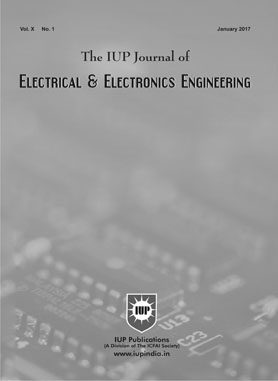
April'23
The IUP Journal of Electrical and Electronics Engineering
Focus
In the paper "Output Stages of Operational Amplifiers Based on Gallium Arsenide NJFET and Bipolar PNP Transistors", by Zhuk A A, Prokopenko N N, Chumakov V E and A V Kunts, various circuit designs are presented for the output stage of operational amplifiers with arsenide gallium n-channel field-effect transistors. The simulation results show that the proposed circuit solutions provide the maximum amplitudes of positive and negative output voltages, close to the supply voltages.
Lithium-Ion Batteries (LIB) are used in a variety of systems from small electronic devices to electric vehicles due to various advantages like high energy density, long cycle of life, absence of high self discharge rate etc. However, LIB are fragile and require protection circuit to maintain safe operation. In the research note "Design and Fabrication of Lithium-Ion Batteries with Different Nodes", by Akram Muntaser, Lithium Cobalt Oxide (LCO) cathode is fabricated and used for making two-battery coin cells with different anodes lithium and graphite and the same electrolyte. It was observed that the charge and discharge rates have considerably improved.
Editor-in-Chief
Model Predictive Control of Autonomous Vehicles to Enhance Driving Performance and Safety
The paper explores the potential benefits of using Model Predictive Control (MPC) algorithm to enhance the driving performance and safety of autonomous vehicles. MPC is a control strategy that uses a mathematical model of the vehicle and its environment to predict future behavior and make optimal control decisions. The paper first provides an overview of MPC and its applications in the control of autonomous vehicles and then discusses the benefits of MPC, including improved vehicle handling, increased fuel efficiency and enhanced safety. It also examines some of the challenges associated with implementing MPC in autonomous vehicles, such as computational complexity and model uncertainty. Finally, the paper concludes with a discussion on future research directions, including the need for more accurate models and improved computational algorithms to make MPC more practical for real-world applications.
Output Stages of Operational Amplifiers Based on Gallium Arsenide njfet and Bipolar pnp Transistors
The paper considers schematics of low-power Output Stages (OS) and class AB Buffer Amplifiers (BA) for analog microcircuits realized on arsenide gallium n-channel field-effect transistors with control p-n junction and arsenide gallium bipolar p-n transistors within combined processes. The developed output stages are characterized by a relatively small static current consumption (about 100-200 mA), provide operation at load resistances greater than 1-2 kW, and have, as a rule, an increased input resistance. The maximum values of BA output currents for the positive polarity of the output voltage (vout) are determined by the width of the JFET channel, and for the negative vout half-wave, by the base current amplification factor of the BJT. In this connection, it is recommended to use compound Darlington p-n-p transistors in BA circuits. The results of computer simulation of the amplitude characteristics of push-pull BAs in LTspice at different load resistances show that the proposed circuit solutions provide the maximum amplitudes of positive and negative output voltages, close to the supply voltages. The circuit solutions considered are recommended for use in low-power operational amplifiers, including those operating under harsh operating conditions. The novelty of the paper lies in the investigation of a family of new push-pull class AB output stages for operational amplifiers, protected by 4 Russian patents and implemented under severe circuit restrictions on the types of GaAs transistors used (nJFET and nBJT).
Research Note
Design and Fabrication of Lithium-Ion Batteries with Different Nodes
Over the past few decades, portable
electronics have been playing a prominent
role in daily life, including Micro-
Electromechanical Systems (MEMS) and
Nano-Electromechanical Systems (NEMS)
(Lee et al., 2003; Albano et al., 2007;
Muntaser et al., 2015; and Muntaser and
Buaossa, 2021). These devices, among
many others, require a reliable energy
storage and conversion device in order to
function properly, the typical device being
a battery. Many batteries are available for
these applications, but the most promising
proves to be Lithium-Ion Batteries (LIBs),
mostly due to their ability to provide high
voltages and large energy storage densities
(Tarascon and Armand, 2010). LIBs have
a very wide range of applications, including
environment-friendly electric vehicles
(Muntaser et al., 2016; and Elwarfalli
et al., 2019) and rechargeable phone
batteries (Kitaura et al., 2011; Elwarfalli
et al., 2016; and Muntaser et al., 2017).
The main advantage of LIBs (Li-ion) is their
high energy density. They have a long cycle
of life. Li-ion does not suffer from high selfdischarge
rate, and memory effect of
Nickel-Cadmium (NiCd) and Nickel Metal
Hydride (NiMH) batteries. Unlike Sealed
Lead Acid (SLA) and NiCd, LIBs do not
contain toxic heavy metals. The main
disadvantage of LIBs is that they require
careful attention to safety; overcharging,
overheating or short-circuiting a charged
LIB can result in fire or explosion (Isaacson
et al., 2000).
The term "LIB" refers to a diverse family
of battery chemistries. All LIBs use a
process known as intercalation, in which
lithium ions are incorporated into the
structure of the electrode material. Lithium
ions move from the positive to the negative
electrode during charging and from the
negative to the positive electrode as the
battery is discharged (Zaghib et al., 2012;
and Muntaser et al., 2017). Most types of
LIBs available today differ in the composition
of their positive electrode (cathode). New
materials for the negative electrode are also
being developed, but few of these are
available on the market (Patel, 2011).